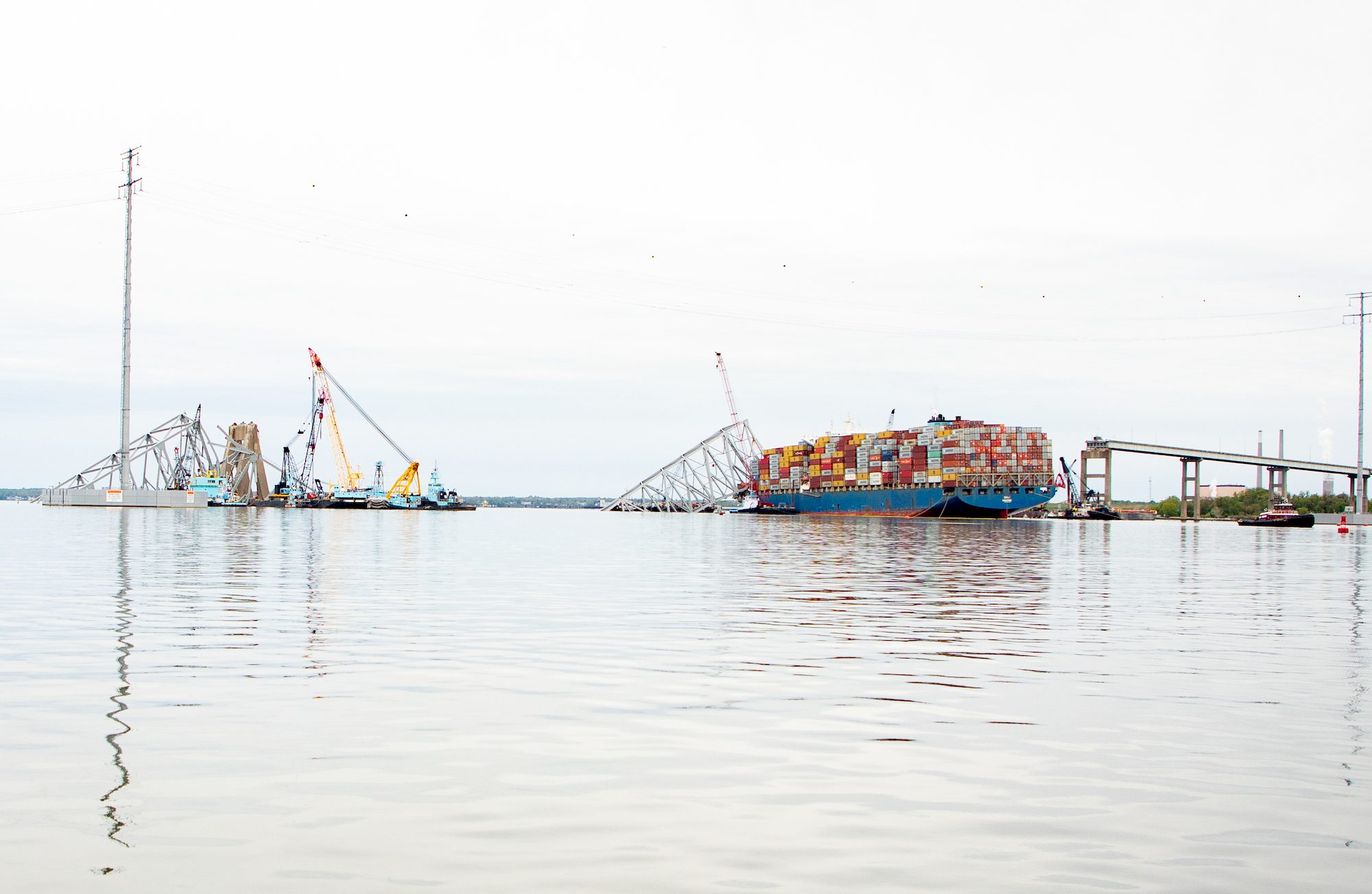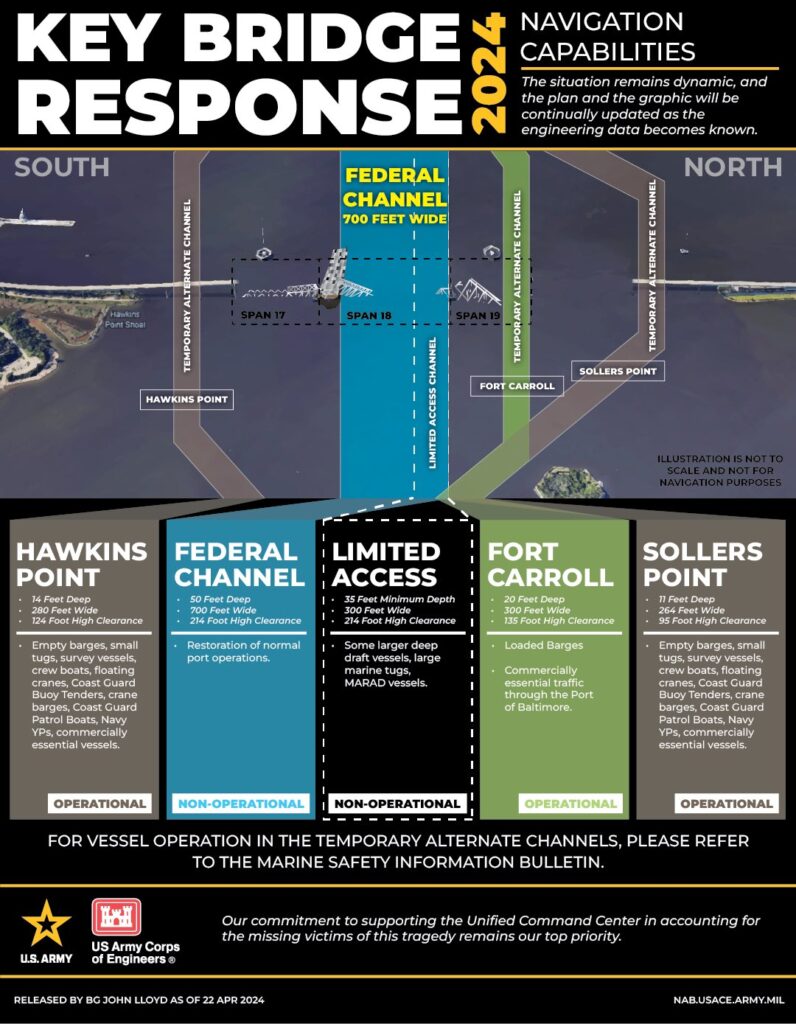Ships Fleeing The Red Sea Now Face Perilous African Weather
By Alex Longley and Paul Burkhardt (Bloomberg) –Ships sailing around the southern tip of Africa are wrestling with a bout of bad weather that has already run one vessel aground and...


Wreckage removal operations continue at the Fort McHenry Federal Navigation Channel response, April 21, 2024. USACE Photo
The U.S. Army Corps of Engineers (USACE) has announced significant progress in clearing a major obstruction in the Port of Baltimore which will allow part of main federal channel to be open to larger commercial vessels, including those trapped behind the fallen bridge.
Monday’s removal of a 560-ton section of structural steel marked a major accomplishment in the temporary reopening of a 35-foot-deep Limited Access Channel (LAC) planned for Thursday, keeping its promise to open the deeper channel by the end of April. Three temporary alternative channels have already been open with controlling depths of 20, 14 and 11 feet, respectively.
The Captain of the Port has provided details of the LAC in a Marine Safety Information Bulletin (MSIB 043-24). The planned channel will have a controlling depth of 35 feet, horizontal clearance of 300 feet, and vertical clearance of 214 feet, due to overhead power lines.
Unlike the existing alternate channels, the LAC is part of the northern section of the wider federal channel that had been blocked since the collapse of Baltimore’s Francis Scott Key Bridge on March 26.
Once operational, the channel will allows passage for commercial vessels into the Port of Baltimore and allow the departure for some deep draft commercial vessels currently stuck in the harbor due to the bridge collapse.
The channel will initially only be open for a limited time, from April 25 until April 29 or 30, depending on weather. After, the channel will close until May 10 to allow the start of “critical and highly dynamic salvage operations” as part of the effort to fully clear the 50-foot-deep federal channel.


“In achieving this important milestone, we continue to signal our resolute commitment to the people of Baltimore and the nation that we will not rest until the Port of Baltimore returns to normal operations,” said USACE Commanding General, Lt. Gen. Scott Spellmon.
The progress allows the USACE and its partners to work towards the full reopening of the 50-foot-deep Fort McHenry Federal Channel.
There are currently seven international commercial ships stuck behind the wreckage in Baltimore, including bulk carriers JY River and Phatra Naree, Klara Oldendorff, the car carrier Carmen, cargo ships Saimaagracht and Balsa 94, and a tanker, the Palanca Rio. With the exception of the Klara Oldendorff, all have reported drafts within the 35-foot limit.
There are also 4 government-owned Ready Reserve Force vessels, the roll-on/roll-off vessels Cape Washington and Gary I. Gordon, as well as two fast sealift ships, SS Antares (T-AKR-294) and SS Denebola (T-AKR-294).
Due to its location near the grounded M/V Dali, transits through the channel will be limited to 5 knots. Vessels will be required to provide their dimensions and displacement for assessment. The MSIB said vessels over 60,000 long tons will likely not be allowed to transit. Those under 50,000 long tons will likely be allowed, and those between 50,000 and 60,000 long tons will be closely evaluated.
Vessels using the channel need a Maryland State pilot and two escort tugs, ahead and astern on centerline, with a 3 foot under keel clearance requirement. Transits are limited to winds less than 15 knots.
The next phase of the project involves conducting sonar surveys by the USACE, placement of navigation aids by the U.S. Coast Guard, and the issuance of updated nautical charts by the National Oceanic and Atmospheric Administration. Port officials will then evaluate the possibility of resuming commercial one-way maritime traffic in and out of the Port of Baltimore on a case-by-case basis.
USACE Baltimore District Commander Col. Estee Pinchasin praised the efforts of all involved, noting the complexity and risk of the salvage work. “The level of coordination both behind the scenes and out on the water is exceptional,” she said. “As part of the Unified Command working diligently to fully restore commerce to the Port of Baltimore, we have not and will not lose focus of what is most important – the safety of our crews and accounting for those still missing to bring closure to their families.”
Join the gCaptain Club for curated content, insider opinions, and vibrant community discussions.


Join the 107,119 members that receive our newsletter.
Have a news tip? Let us know.
Access exclusive insights, engage in vibrant discussions, and gain perspectives from our CEO.
Sign Up




Maritime and offshore news trusted by our 107,119 members delivered daily straight to your inbox.



Essential news coupled with the finest maritime content sourced from across the globe.
Sign Up